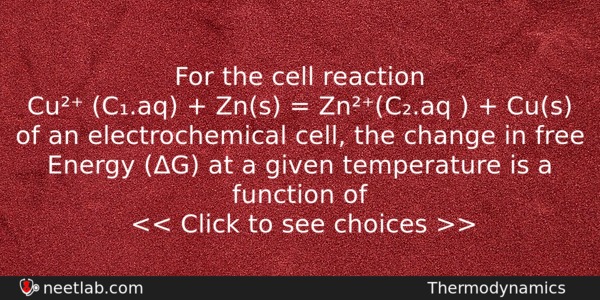| ⇦ | 
| ⇨ |
For the cell reaction
Cu²⁺ (C₁.aq) + Zn(s) = Zn²⁺(C₂.aq ) + Cu(s)
of an electrochemical cell, the change in free Energy (ΔG) at a given temperature is a function of
Options
(a) ln (C₂)
(b) ln (C₂/C₁)
(c) ln (C₁)
(d) ln (C₁ + C₂)
Correct Answer:
ln (C₂/C₁)
Explanation:
No explanation available. Be the first to write the explanation for this question by commenting below.
Related Questions: - Reaction of diborane with ammonia gives initially
- Bleaching powder is obtained by treating Cl₂ with
- How many P = O bond present in (HPO₃)₃
- In which process,fused sodium hydroxide is eletrolysed for extraction of sodium
- The amount of energy,which is released due to the addition of extra electron
Topics: Thermodynamics
(179)
Subject: Chemistry
(2512)
Important MCQs Based on Medical Entrance Examinations To Improve Your NEET Score
- Reaction of diborane with ammonia gives initially
- Bleaching powder is obtained by treating Cl₂ with
- How many P = O bond present in (HPO₃)₃
- In which process,fused sodium hydroxide is eletrolysed for extraction of sodium
- The amount of energy,which is released due to the addition of extra electron
Topics: Thermodynamics (179)
Subject: Chemistry (2512)
Important MCQs Based on Medical Entrance Examinations To Improve Your NEET Score
18000+ students are using NEETLab to improve their score. What about you?
Solve Previous Year MCQs, Mock Tests, Topicwise Practice Tests, Identify Weak Topics, Formula Flash cards and much more is available in NEETLab Android App to improve your NEET score.
Share this page with your friends

Leave a Reply